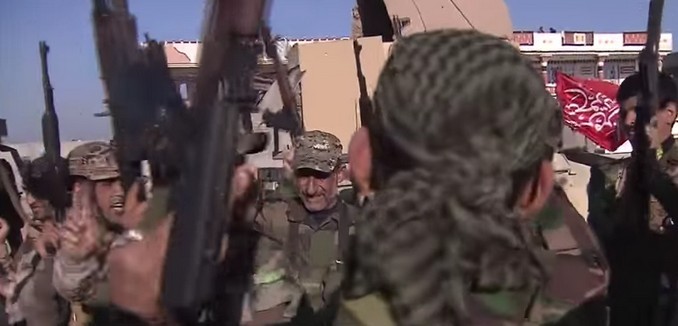An Iran-backed militia has emerged as the primary Iraqi military force fighting the Islamic State of Iraq and Syria (ISIS), according to a report Tuesday by Bloomberg View’s Eli Lake.
In an interview this week, Hadi al-Amiri, the founder and leader of Iraq’s oldest and most powerful Shiite militia, the Badr Organization, told me the U.S. ambassador recently offered air strikes to support the Iraqi army and militia ground forces under his command. This has placed the U.S. in the strange position of deepening an alliance with the Islamic Republic of Iran for its war against Islamic extremists.
Late last year, the U.S. formally committed to train and equip three divisions of the Iraqi army. While some senior U.S. officials have had positive words for Iran’s role in the fight against Islamic State warriors, official U.S. policy is to support the integration of Iraq’s sectarian militias into the Iraqi Security Forces.
In Diyala Province northeast of Baghdad, however, it’s the other way around. On a tour of areas recently liberated from Islamic State control, General Ali Wazir Shamary told me that ultimately his orders came through a chain of command that originated with Amiri. In other words, the Iraqi army is integrating into Amiri’s Badr Organization in Diyala as opposed to integrating the militias into the army.
Lake writes that Amiri confirmed Shamary’s description of the chain of command. Amiri also told Lake that he meets regularly with Gen. Qassem Soleimani, the commander of the elite Qods Force of Iran’s Islamic Revolutionary Guard Corps.
Michael Flynn, a retired American general and former head of the Defense Intelligence Agency, warned:
“Members of the Badr Corps are responsible for killing many American Soldiers and they will likely do it again if given the chance. … We built an Iraqi military to defeat all the enemies of Iraq and groups like the Badr Corps represent enemies of a stable, secure, and inclusive Iraq. As soon as we get done helping them with ISIS, they will very likely turn on us.”
The Badr Corps (or, as it is sometimes called, Badr Brigades) also have a troubling record of documented human rights abuses, including “kidnapping and killing [people], driving them from their homes, setting homes on fire.”
In addition to his work with Iraqi militias, Soleimani is reported to have taken control of the Syrian army at the behest of Tehran in 2013.
In a recent article for Mosaic Magazine, Michael Doran, a senior fellow at the Hudson Institute, outlined the negative implications allowing Iran such great control has for American policy.
With American acquiescence, Iran is steadily taking control of the security sector of the Iraqi state. Soon it will dominate the energy sector as well, giving it effective control over the fifth largest oil reserves in the world. When the announced goal of the United States is to build up a moderate Sunni bloc capable of driving a wedge between Islamic State and the Sunni communities, aligning with Iran is politically self-defeating. In both Iraq and Syria, Iran projects its power through sectarian militias that slaughter Sunni Muslims with abandon. Are there any Sunni powers in the region that see American outreach to Tehran as a good thing? Are there any military-aged Sunni men in Iraq and Syria who now see the United States as a friendly power? There are none.
In theory, one might argue that although an association with Iran is politically toxic and militarily dangerous, the capabilities it brings to the fight against the Islamic State more than compensate. But they don’t. Over the last three years, Obama has given Iran a free hand in Syria and Iraq, on the simplistic assumption that Tehran would combat al-Qaeda and like-minded groups in a manner serving American interests. The result, in both countries, has been the near-total alienation of all Sunnis and the development of an extremist safe haven that now stretches from the outskirts of Baghdad all the way to Damascus. America is now applying to the disease a larger dose of the snake oil that helped cause the malady in the first place.
In How Iraq Became a Proxy of the Islamic Republic of Iran, which was published in the December 2014 issue of The Tower Magazine, Jonathan Spyer and Aymenn Jawad Al-Tamimi document that it was Soleimani who crafted Iraq’s response to ISIS beginning last summer.
Almost immediately, Qassem Suleimani, commander of the Quds Force of the IRGC—the agency tasked with the creation and use of proxy political and military forces—was sent to Baghdad. Very clearly, his task was to coordinate the Iraqi response.
His influence appears to have been decisive in shaping the Iraqi response. Predictably, it involves the use of militias and Shia sectarianism along the lines pioneered in other countries. As an Iraqi official quoted by The Guardian put it, “Who do you think is running the war? Those three senior generals who ran away? Qassem Suleimani is in charge. And reporting directly to him are the militias.” Since then, Suleimani has guided much of the fighting against the I.S., and has even been physically present at a number of key engagements.
Alongside the Quds Force leaders, there are reliable reports of dozens of IRGC and Lebanese Hezbollah advisers on the ground in Iraq. In addition, Iraqi paramilitaries deployed in Syria have been returned to Iraq in order to join the fight.
So, what is happening in Iraq today is directly analogous to what happened in Syria. The Iran-aligned, Shia-dominated government in Baghdad is being protected from Sunni insurgents through the efforts and methods of the IRGC’s Quds Force, the most effective instrument of Iran’s regional policy. This, of course, has major implications for Western policy, which at the current time is acting as the air wing for this campaign.
[Photo: CBS This Morning / YouTube ]




